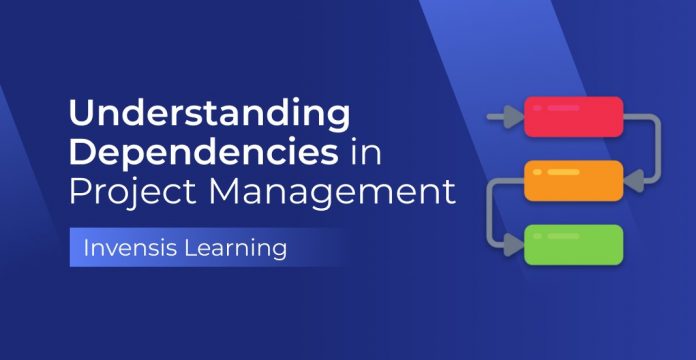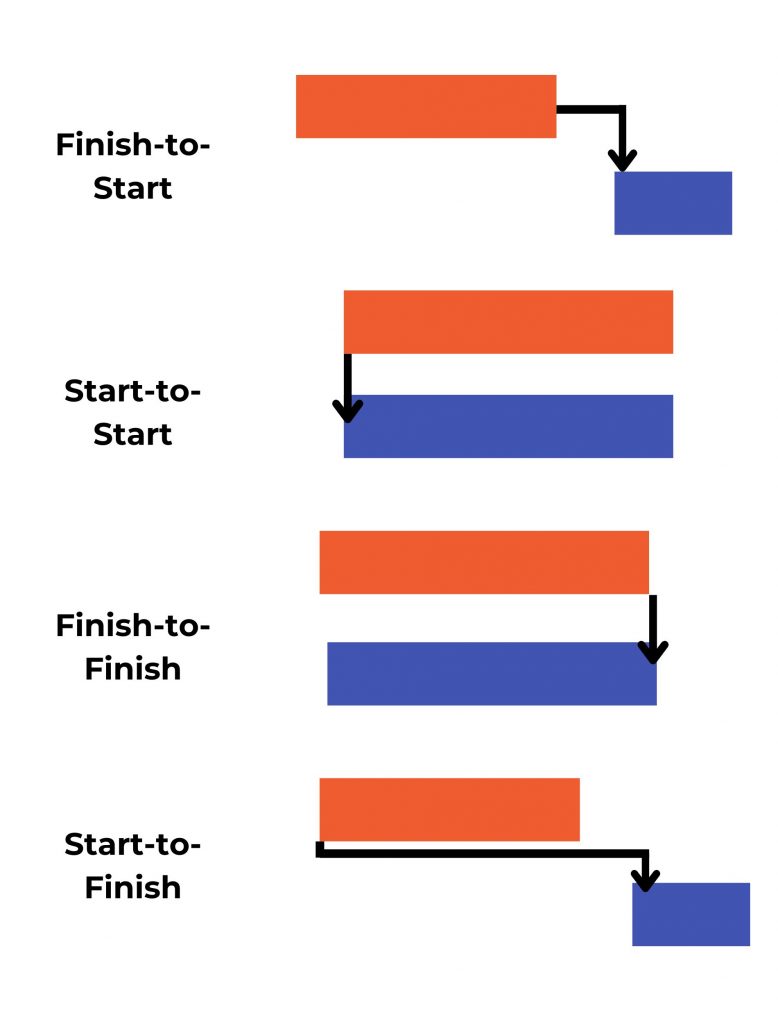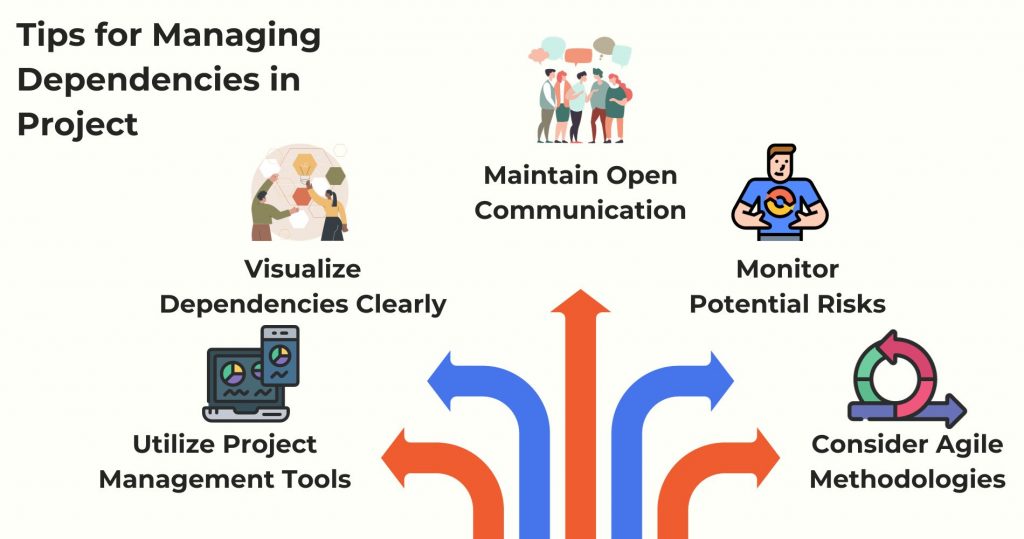
Projects frequently involve the sequential handoff of tasks from one team member to another. However, certain project tasks depend on the completion of others before they can commence. This interconnection of tasks is referred to as a dependency. In project management, dependencies are the invisible threads that hold everything together. Like puzzle pieces, project tasks rely on each other to create a cohesive picture of success.
In this blog, we’ll look into dependencies in project management, exploring their types, importance, and how to manage them effectively.
What Are Dependencies in Project Management?
Dependencies in project management are the critical connections that underlie the smooth progression of a project. They are factors or tasks that rely on the input or completion of other factors to determine the project’s timeline, stability, and efficiency. Understanding dependencies is like having the blueprint that guides you through the intricate maze of project execution.
Let’s take a closer look at what project dependencies entail:
Understanding Project Dependencies
Imagine a complex jigsaw puzzle; each piece depends on the shape and position of the others to complete the picture. Similarly, in project management, tasks and elements are interconnected in intricate ways. These interdependencies can significantly impact the project’s outcome. Project managers study dependencies to gain insights into the requirements and how various factors like labor, materials, and resources interact.
By delving into dependencies, project managers can:
- Enhance Quality and Consistency: Identifying dependencies allows project managers to make informed adjustments, ensuring that each task fits seamlessly into the project’s timeline and contributes to its overall quality and consistency.
- Streamline Workflows: Dependencies act as the gears that need to be turned in unison for the project to move forward. Understanding these relationships ensures that workflows progress smoothly and accurately
Importance of Project Dependencies
Project dependencies serve as the backbone of effective project planning and execution. Understanding their significance is crucial for ensuring your projects are completed successfully, on time, and within budget.
Let’s delve into why project dependencies are so important:
Sequencing and Organization
Project dependencies provide a structured sequence for tasks. They outline how tasks should be tackled, ensuring work progresses logically and efficiently. This sequencing helps teams stay organized, preventing confusion and chaos in project execution.
Efficiency and Resource Optimization
By identifying dependencies, project managers can allocate resources more efficiently. Teams can focus on tasks ready to start, maximizing productivity and minimizing downtime. This efficient allocation of resources is essential for meeting project deadlines and budget constraints.
Risk Mitigation
Understanding dependencies allows project managers to address potential risks proactively. By identifying critical dependencies, you can develop contingency plans to mitigate the impact of delays or issues that may arise. This risk management strategy helps keep the project on track.
Budget and Timeline Control
External dependencies, such as tools or services, can have a direct impact on your project’s timeline and budget. Failure to manage these dependencies can lead to unexpected delays and additional costs. It’s crucial to account for them to maintain financial control.
Security and Compliance
Neglecting to manage dependencies can also pose security risks. Using outdated software versions or libraries with known vulnerabilities can jeopardize the security of your project. Regularly updating and monitoring dependencies is essential for maintaining a secure and compliant project environment.
By recognizing and managing dependencies effectively, you can ensure that your projects run smoothly, are delivered on time and within budget, and maintain the highest standards of quality and security.
Popular Terminologies Used in Project Dependencies
Here are a few terminologies commonly used in the context of project dependencies:
- Dependency Relationship: This refers to the connection or linkage between tasks or activities, indicating that one task relies on the completion of another
- Critical Path: The sequence of tasks that, if delayed, would extend the overall project duration. Identifying the critical path is essential for project scheduling
- Resource Constraint: This occurs when there is limited availability of resources (e.g., workforce, equipment) that can impact project tasks and dependencies
- Float or Slack: The amount of time a task can be delayed without affecting the project’s overall timeline. Tasks with zero float are on the critical path
- Lead Time: The amount of time a task can be accelerated or started before its dependent task without causing issues
- Lag Time: A delay added between two tasks in a dependency relationship. It represents a waiting period between the completion of one task and the start of another
- External Dependency: As previously discussed, factors outside the organization’s control can affect project outcomes
- Dependencies Matrix: A visual representation that outlines the various task dependencies in a project, helping project managers track and manage them effectively
- Interdependencies: The complex relationships between multiple tasks or sub-projects within a larger project
- Dependency Analysis: Examining and assessing the relationships between tasks to identify critical dependencies and potential risks
These terms are fundamental in project management and describe, analyze, and manage the intricate web of relationships that govern project tasks and timelines.
Master Project Management by enrolling in Invensis Learning’s globally recognized Project Management certification courses!
Types of Dependencies in Project Management
Various types of dependencies exist, influenced by both internal and external factors. Below, we outline several primary categories of project dependencies.
Logical Dependencies
Referred to as causal dependencies, these dependencies constitute essential components for a project’s culmination. They often represent the ultimate output of all preceding tasks and cannot be concurrently pursued with other tasks. For instance, if you lack a team member, delegating a task to someone else becomes impossible. In this scenario, hiring an additional team member becomes a logical dependency.
Resource Dependencies
Resource-based dependencies come into play when two or more tasks necessitate the same resources for completion. Such resources may include team members, machine components, funding, or skilled professionals. For example, when you and the finance team require the hard drive containing this month’s reports, a resource dependency arises, necessitating a wait for one of the parties.
Preferential Dependencies
These dependencies typically hinge on team members, other stakeholders, and established industry practices. Preferential dependencies emerge when tasks are scheduled to adhere to established standard practices. While ignoring preferential dependencies may not impede project completion, it can lead to quality-related issues.
Quality-Related Dependencies
Quality-related dependencies form an integral part of the quality assurance process, relying on industry best practices or convenience. These dependencies are crucial for ensuring the quality and consistency of project deliverables.
External Dependencies
Certain elements of a project manager’s control are unaccounted for in the project plan—these are external dependencies. Erica Tahan, Digital Marketing Project Manager at WITHIN, frequently encounters external dependencies, particularly in client communications and requests.
Implementing project management software to facilitate client communication and accountability has streamlined processes, reduced the need for frequent meetings and extensive email exchanges, and fostered transparency in interactions with client points of contact. Features like task assignment, notification setup for impending deadlines, and automated reporting have significantly mitigated past dependency challenges and fostered improved relationships between internal teams and client stakeholders.
Types of Task Dependencies in Project Management
Comprehending and pinpointing the connections among task dependencies is a pivotal aspect of a project manager’s role.
Below are the descriptions of four distinct task dependencies in project management.
Finish-to-Start (FS)
In a Finish-to-Start dependency, Task B cannot commence until Task A has been completed. It represents a sequential relationship where one task must conclude before the next can begin.
Start-to-Start (SS)
A Start-to-Start dependency dictates that Task B cannot initiate until Task A starts. This type of dependency highlights tasks that need to move forward simultaneously. For instance, think of two construction teams coordinating their efforts to build different parts of a structure.
Finish-to-Finish (FF)
With a Finish-to-Finish dependency, Task A can only be considered complete once Task B concludes. This type of relationship ensures that two tasks, although distinct, must synchronize their endings. An example might be finalizing a project sale once the budget and timeline are finished.
Start-to-Finish (SF)
Lastly, the Start-to-Finish dependency signifies that Task B cannot be completed until Task A begins. This less common relationship entails that the initiation of one task triggers the completion of another. Imagine a scenario where you can only close a deal once negotiations have started.
- Finish-to-Start: Task A must finish before Task B can begin.
- Start-to-Start: Task B must start when Task A starts.
- Finish-to-Finish: Task B’s completion depends on Task A’s completion.
- Start-to-Finish: Task B can only be completed when Task A starts.
Internal Dependencies in Project Management
In project management, internal dependencies are key in shaping the path to project success. These dependencies encompass various categories, each influencing the project’s progression in its own unique way.
Here, we delve into the intricacies of internal dependencies, highlighting their key categories and providing illustrative examples.
Task-Based Dependencies
Task-based dependencies form the bedrock of project progression. They follow a logical sequence of tasks that must be completed in order. For instance, printing shipping labels precedes the mailing of customer orders, illustrating the sequential nature of task-based dependencies.
Team-Based Dependencies
Collaboration is often essential in project management, leading to team-based dependencies. These dependencies necessitate the cooperative efforts of different teams to achieve project milestones. An exemplary instance is the requirement to capture product photos for sales brochures, which hinges on the production team delivering a prototype for photography.
Approval-Based Dependencies
In some cases, project progress depends upon obtaining necessary approvals. Approval-based dependencies revolve around the need for official consent or authorization. For instance, the acquisition of large-scale manufacturing equipment necessitates approval from the Chief Financial Officer (CFO) before proceeding.
Best Practices-Based Dependencies
Certain dependencies are grounded in best practices that optimize task completion. Adhering to these practices ensures efficiency and quality.
Resource-Based Dependencies
Resource-based dependencies revolve around the availability of specific resources required to initiate a task. These resources can encompass materials, equipment, or other essentials. For example, printing sales brochures relies on the availability of the correct cardstock and ink.
Software-Based Dependencies
Software is key in project management. Software-based dependencies require software inputs or updates to facilitate task progression. Regular updates to storage software to ensure secure data access are a prime example of such a dependency.
Understanding and effectively managing these internal dependencies is essential for project managers to ensure the seamless flow of tasks, timely project completion, and attaining project objectives.
External Dependencies in Project Management
External dependencies present a distinct set of challenges and uncertainties. These dependencies are factors lying beyond the direct control of a business or project team, making them often unpredictable and demanding meticulous management.
Here, we explore the external dependencies, shedding light on their nature and providing noteworthy examples.
The Uncontrollable Variables
External dependencies encompass many factors that can significantly influence project outcomes. These variables are external to the organization but can exert considerable impact. Here are some common categories of external dependencies:
Deliveries
The timely arrival of materials and supplies is crucial for various projects. Supply chain disruptions, delivery delays, or material shortages can impede progress. For instance, commencing the construction of a product is only possible if the necessary materials have yet to arrive.
Traffic
Traffic congestion can disrupt the timely arrival of equipment, impacting project schedules. For example, setting up a trade show booth becomes impossible when essential equipment is stuck in a traffic jam.
Weather
In industries like construction, favorable weather conditions are important. Adverse weather events, such as hurricanes or storms, can stop outdoor projects and extend timelines. Building a house during a hurricane is not only impractical but also unsafe.
Finances
Financial dependencies, especially concerning loans and funding, can introduce delays. Initiating major purchases or investments may hinge on the availability of funds. When loan approvals or funding processes are timely, it can help the project’s progress.
Managing external dependencies requires foresight, adaptability, and contingency planning. Project managers must develop strategies to mitigate the impact of these external variables, fostering resilience and agility in the face of unpredictable circumstances.
Best Practices for Managing Dependencies in Project
Effective dependency management is vital for project success. To ensure projects run smoothly and on schedule, adopting best practices in dependency management is essential.
Management
Effectively managing project dependencies is crucial for ensuring project success and maintaining efficiency. While it may seem overwhelming initially, following these best practices can help you navigate and organize task dependencies, setting your projects on the path to success:
Utilize Project Management Software
Invest in project management tools and software that align with your team’s needs. These tools can assist in your project plan, track activities, and identify dependent tasks. This technology aids in maintaining project schedules and ensures everyone is on the same page.
Break Down Processes into Smaller Batches
Consider breaking down tasks into smaller, manageable batches. This approach, often associated with Agile methodologies, can reduce hand-offs and bottlenecks. Smaller batches allow for more efficient task handovers and can help optimize team productivity.
Visualize Dependencies Clearly
Use visual tools like Gantt charts or Kanban boards to create a visual representation of your project’s tasks and their dependencies. Visualization helps team members understand task sequences, project stages, and interdependencies, fostering better project management.
Maintain Open Communication
Effective communication is key to handling dependencies. Keep the lines of communication open with team members, stakeholders, and clients. Ensure everyone understands the project’s progress, dependencies, and potential bottlenecks. Swift and productive communication is vital to maintaining strong stakeholder relationships.
Monitor Potential Risks
When creating a project plan, identify and assess potential internal dependencies that could arise during the project. Consider factors like team workload and external vendors. While you can’t predict every risk, monitoring dependencies lets you stay proactive in ensuring timely deliverables.
Consider Agile Methodologies
Evaluate your project management approach. In some cases, switching from a traditional Waterfall methodology to Agile can reduce bottlenecks and dependencies. Agile’s iterative and collaborative nature allows for ongoing stakeholder feedback, which can prevent late-stage surprises and changes.
Encourage Stakeholder Engagement
Foster a culture of engagement among project stakeholders. Encourage stakeholders to communicate openly about task delays or issues. When stakeholders are proactive in sharing information, team members can adjust their timelines and resources accordingly, reducing the impact of delays.
By implementing these best practices, you can effectively manage project dependencies, enhance project outcomes, and increase the likelihood of delivering projects on time and within scope.
Elevate your career to a new height by enrolling in Invensis Learning’s PMI authorized PMP certification course!
Project Dependencies Examples
Understanding project dependencies is crucial for effective project management across various industries, including construction, healthcare, IT, marketing, etc. Here are examples of different types of project dependencies commonly encountered in these industries:
Logical Dependencies
- Construction: In construction, logical dependencies dictate that structures must be built in a specific order to ensure stability and functionality. For instance, building foundations precedes erecting walls and roofs.
- IT: IT projects, like app development, follow a logical progression from conception to design, programming, testing, and finally, launch. Each step builds upon the previous one to create a functional application.
- Marketing: Marketing campaigns must adhere to a logical sequence, starting with conception and research, then campaign design and rollout. This logical flow ensures that the campaign effectively reaches its target audience.
Resource Dependencies
- Construction: Construction projects can commence once the necessary building materials are on-site. The availability of materials like concrete, steel, and lumber is critical to project progress.
- IT: IT projects, such as app development, rely on the availability of skilled software engineers, high-end computer hardware, and reliable internet connections to proceed smoothly.
- Marketing: Marketing campaigns, particularly direct mail efforts, depend on resources like large-scale printing machines, access to billboards, and the availability of specific cardstock or ink for their success.
Preferential Dependencies
- Construction: Best practices dictate that the cement foundation must be cured and dried before further construction occurs. This ensures the structural integrity of the building.
- IT: In IT, it is a best practice to thoroughly test new software for bugs and errors before deploying it for general use, ensuring a smooth user experience.
- Marketing: For marketing, preferential dependencies involve conducting focused market research before designing an ad campaign. This practice ensures that the campaign resonates with the intended audience.
Cross-Team Dependencies
- Construction: In construction, cross-team dependencies require plumbing and electrical teams to complete their installations before the drywall team can close up the walls.
- IT: IT projects often involve cross-team dependencies, such as software engineers providing usable demos or final products to sales teams for customer presentation and sales.
- Marketing: Marketing teams rely on production teams to produce the products and services they promote and sell to customers.
External Dependencies
- Construction: External factors like inclement weather, such as rain or snow, can disrupt construction schedules and delay project timelines.
- IT: IT projects may face external dependencies like security vulnerabilities or large-scale power outages, impacting project schedules and budgets.
- Marketing: In marketing, external dependencies can arise when competitors release identical campaigns before the intended rollout, necessitating adjustments to the campaign schedule.
These examples illustrate how project dependencies vary across industries but share common principles of sequencing, resource allocation, best practices, inter-team collaboration, and external factors that can affect project outcomes. Effective management of these dependencies is essential for project success.
Conclusion
Understanding and effectively managing dependencies in project management is essential for project success. It ensures smoother workflows, timely deliverables, and better project outcomes.
To enhance your skills in this crucial aspect of project management, consider enrolling in Invensis Learning’s PMP Certification course. Gain the knowledge and expertise needed to navigate dependencies and drive your projects to success confidently.
















